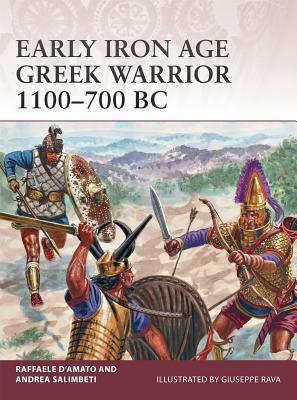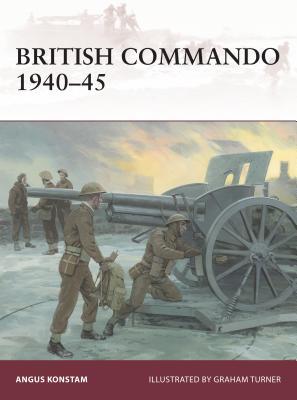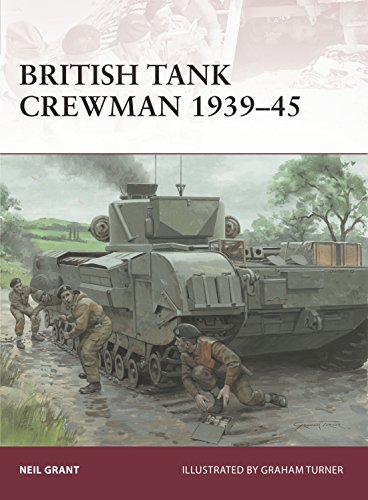


Books in series

Norman Knight AD 950-1204
1993

Waffen-SS Soldier
1940-1945
1993

Viking Hersir 793-1066 AD
1993

US Cavalryman 1865–90
1993

Anglo-Saxon Thegn AD 449-1066
1993

Confederate Infantryman 1861-65
1993

Samurai 1550–1600
1994

British Cavalryman 1792–1815
1994

Late Roman Infantryman 236-565 AD
1994

Saracen Faris AD 1050-1250
1994

English Longbowman 1330-1515
1995

German Stormtrooper 1914-18
1995

Union Cavalryman 1861-65
1995

Zulu 1816-1906
1995

Late Roman Cavalryman AD 236-565
1995

British Tommy 1914-18
1996

Germanic Warrior AD 236-568
1996

Knight of Outremer AD 1187-1344
1996

British Redcoat, 1740-93
1997

British Redcoat 1793-1815
1997

Highland Clansman 1689-1746
1997

Imperial Guardsman 1799-1815
1997

US Marine Rifleman in Vietnam
1998

Austrian Grenadiers and Infantry 1788-1816
1998

Italian Militiaman 1260–1392
1999

US Paratrooper 1941-45
Weapons, Armour, Tactics
2000

Greek Hoplite 480-323 BC
2000

Green Beret in Vietnam
1957-73
2002

Ashigaru 1467-1649
2001

Celtic Warrior
300 BC-AD 100
2001

Union Infantryman 1861-65
2001

Aztec Warrior
AD 1325-1521
2001

Knight Hospitaller (1)
1100-1306
2001

Confederate Artilleryman 1861-65
2001

English Medieval Knight 1400-1500
2001

Grey Wolf
U-Boat Crewman of World War II
2001

German Seaman 1939–45
2001

Fallschirmjäger
German Paratrooper 1935-45
2001

Gladiators
100 BC-AD 200
2001

The Conquistador
1492-1550
2001

Knight Hospitaller (2)
1306-1565
2001

Redcoat Officer
1740-1815
2002

Matchlock Musketeer 1588-1688
2002

Ironsides
English Cavalry 1588–1688
2002

Panzer Crewman 1939-45
1939-1945
2002

British Rifleman, 1797-1815
2002

English Medieval Knight 1200-1300
2002

Landsknecht Soldier 1486-1560
2002

Pictish Warrior AD 297 - 841
2002

Russian Grenadiers and Infantry 1799–1815
2002

US Naval Aviator
1941–45
2002

Confederate Cavalryman 1861-65
1703

Imperial Japanese Naval Aviator 1937-45
2003

French Napoleonic Infantryman 1803-15
2002

English Medieval Knight 1300-1400
2002

Sharpshooters of the American Civil War 1861–65
2002

German Security and Police Soldier 1939–45
2002

French Revolutionary Infantryman 1791-1802
2003

Ninja 1460-1650
2003

US Army Ranger 1983-2002
Sua Sponte - Of Their Own Accord (Warrior, Vol.65
2012

The Cossacks 1799–1815
2003

Continental Infantryman of the American Revolution
2003

Darby's Rangers 1942-45
2003

Japanese Warrior Monks AD 949-1603
2003

Roman Legionary 58 BC-AD 69
2003

Warrior 72
Imperial Roman Legionary AD 161-284
2003

Tito's Partisans 1941–45
2003

Gebirgsjager
German Mountain Trooper 1939-45
2003

Comanche 1800-74
2003

French Soldier in Egypt 1798-1801
The Army of the Orient
2003

US Army Tank Crewman 1941-45
European Theater of Operations (ETO) 1944-45
2004

Warrior 79
2005

Warrior 80
2003

Hungarian Hussar 1756–1815
2003

British Infantryman in South Africa 1877–81
2003

Mongol Warrior 1200-1350
2003

American Colonial Ranger
The Northern Colonies, 1724-64
2004

Boer Commando 1876-1902
2004

Italian Arditi
Elite Assault Troops 1917-1920
2004

US Cavalryman 1891-1920
2004

US Marine Corps Tank Crewman 1965-70
Vietnam
2004

Knight Templar
2004

US Marine Corps Tank Crewman 1941-45
Pacific
2005

Polish Winged Hussar 1576-1775
2005

Japanese Infantryman 1937-45
Sword of the Empire
2005

Carolingian Cavalryman 768-987
2005

French Warship Crews 1789–1805
From the French Revolution to Trafalgar
2005

US Army Infantryman in Vietnam 1965-73
2005

Kampfflieger
Bomber Crewman of the Luftwaffe 1939–45
2005

Nelson's Sailors
2005

Roman Auxiliary Cavalryman
AD 14-193
2006

The Hitler Youth
1933-45
2006

Macedonian Warrior
Alexander's elite infantryman
2006

Tudor Knight
2006

Native American Mounted Rifleman 1861–65
2006

US Marine in Iraq
Operation Iraqi Freedom, 2003
2006

Mau-Mau Warrior
2006

US Marine Corps Raider 1942-43
2006

Hitler's Home Guard
Volkssturmman, Western Front, 1944 - 1945
2006

The Hun
Scourge of God AD 375-565
2006

US Marine Rifleman 1939–45
Pacific Theater
2006

US Army Soldier
Baghdad 2003-04
2007

African American Soldier in the Civil War
USCT 1862-66
2006

Condottiere 1300-1500
Infamous Medieval Mercenaries
2007

Viet Cong Fighter
2007

French Resistance Fighter
France's Secret Army
2007

Byzantine Infantryman
Eastern Roman Empire c.900-1204
2007

American Bomber Crewman 1941–45
2008

Hittite Warrior
2007

Soldier of the Pharaoh
Middle Kingdom Egypt 2055-1650 BCE
2007

Jagdflieger
Luftwaffe Fighter Pilot 1939-45
2008

Soviet Rifleman 1941-45
2007

Teutonic Knight
1190-1561
2007

Pirate of the Far East
811-1639
2007

Highlander in the French-Indian War
1756-67
2008

Native American Code Talker in World War II
2008

US Helicopter Pilot in Vietnam
2008

Frontier Militiaman in the War of 1812
Southwestern Frontier
2008

Tarentine Horseman of Magna Graecia
430-190 BC
2008

Nelson's Officers and Midshipmen
2009

US Army Long-Range Patrol Scout in Vietnam 1965-71
2008

SOE Agent
Churchill's Secret Warriors
2008

French Poilu 1914-1918
2009

North Vietnamese Army Soldier 1958-75
2009

Chindit 1942–45
2009

Royal Marine Commando 1950–82
From Korea to the Falklands
2009

Byzantine Cavalryman c.900-1204
2009

Merrill's Marauders
2009

Blue Division Soldier 1941-45
Spanish Volunteer on the Eastern Front
2009

Galloglass 1250-1600
Gaelic Mercenary Warrior
2010

Italian Blackshirt 1935–45
2010

Ottoman Infantryman 1914-18
2010

German Pionier 1939-45
Combat Engineer of the Wehrmacht
2010

US Combat Engineer 1941-45
2006

Long Range Desert Group Patrolman
The Western Desert 1940-43
2010

Afrikakorps Soldier 1941-43
2006

Carthaginian Warrior 264-146 BC
2010

Samurai Women 1184-1877
2006

Royal Naval Air Service Pilot 1914–18
2006

Bronze Age Greek Warrior 1600-1100 BC
2011

Border Reiver 1513-1603
Warfare and Turmoil on the Anglo-Scottish Border
2011

ANZAC Infantryman 1914-15
From New Guinea to Gallipoli
2011

Early Roman Warrior 753-321 BC
2011

French Foreign Legionnaire 1890-1914
2011

Pirate
The Golden Age
2011

US MACV-SOG Reconnaissance Team in Vietnam
2011

Desert Rat 1940-43
British and Commonwealth troops in North Africa
2011

Tunnel Rat in Vietnam
2012

Roman Republican Legionary 298-105 BC
2012

Spartan Warrior 735-331 BC
2012

RAF Fighter Command Pilot
The Western Front 1939–42
2012

US Army Paratrooper in the Pacific Theater 1943-45
2012

Roman Legionary AD 69-161
2013

Early Aegean Warrior 5000-1450 BC
2013

French Musketeer 1622-1775
2013

Italian Soldier in North Africa 1941-43
2013

Roman Guardsman 62 BC-AD 324
2014

Soviet Partisan 1941-44
2014

Apache Warrior 1860–86
2014

Mamluk 'Askari 1250-1517
2014

British Paratrooper 1940-45
2015

Roman Legionary AD 284-337
The age of Diocletian and Constantine the Great
2015

Patriot Militiaman in the American Revolution 1775–82
2015

Rhodesian Light Infantryman 1961-80
2015

US Marine in World War I
2016

US Army Green Beret in Afghanistan 2001-02
2016

Early Iron Age Greek Warrior 1100–700 BC
2016

British Commando 1940–45
2016

Roman Legionary 109-58 BC
The Age of Marius, Sulla and Pompey the Great
2017

British Tank Crewman 1939-45
2017
Authors



Steven Zaloga is an author and defense analyst known worldwide for his articles and publications on military technology. He has written over a hundred books on military technology and military history, including “Armored Thunderbolt: The US Army Sherman in World War II”, one of the most highly regarded histories of the Sherman Tank. His books have been translated into Japanese, German, Polish, Czech, Romanian, and Russian. He was a special correspondent for Jane’s Intelligence Review and is on the executive board of the Journal of Slavic Military Studies and the New York Military Affairs Symposium. From 1987 through 1992, he was the writer/producer for Video Ordnance Inc., preparing their TV series Firepower. He holds a BA in history from Union College and an MA in history from Columbia University. Mr. Zaloga is also a noted scale armor modeler and is a host/moderator of the World War II Allied Discussion group at Missing-Lynx.com, a modelling website. He is a frequent contributor to the UK-based modeling magazine Military Modelling. He is a member of the Armor Modeling and Preservation Society.

Dr. David C. Nicolle (born 4 April 1944) is a British historian specialising in the military history of the Middle Ages, with a particular interest in the Middle East. David Nicolle worked for BBC Arabic before getting his MA at SOAS, University of London. He gained a PHD at the University of Edinburgh. He lectured in World and Islamic art and architecture at Yarmouk University, Jordan. He was also on the editorial board of the Medieval History Magazine.



Richard S. Lowry is an internationally recognized military historian and author. His last book, New Dawn, the battles for Fallujah, Savas Beatie LLC, May, 2010, was nominated for the 2011 Pulitzer Prize in History, the Military Writer’s Society of America’s 2010 History Award and the Marine Corps Heritage Foundation’s coveted Wallace M. Greene, Jr. award. Richard has previously published the award winning Marines in the Garden of Eden (Berkley Caliber, 2006), The Gulf War Chronicles (iUniverse, 2003 and iUniverse Star, 2008), and US Marine in Iraq: Operation Iraqi Freedom, 2003 (Osprey, 2006). Additionally, he contributed to Small Unit Actions (United States Marine Corps History Division, 2008). He has been published in American Legion Magazine, Armchair General, Military Magazine and The Marine Corps Gazette. Richard was the military consultant to David C. Taylor for the award-winning documentary film, “Perfect Valor.” Richard frequently contributes to his own blog site: http://blog.richardslowry.com. He also writes a continuing military news column at http://www.examiner.com/x-30068-Orlan.... Richard has spoken to many community organizations to include the Military Officers Association, the American Legion, as well as the Marine Corps Association, Marine Corps League, Navy League, the Association of the US Army, Rotary and Kiwanis and recently spoke to Marines of the Marine Forces Command in Norfolk, Virginia. He has spoken on many different subjects relating to the current war in Iraq and Operation Desert Storm. Richard is an award winning author. In 2006, Marines in the Garden of Eden won the Silver Medal for history from the Military Writers Society of America. The Gulf War Chronicles also received recognition from MWSA in 2006 and has achieved Editor’s Choice, Reader’s Choice and STAR distinction from iUniverse. In 2009, “Perfect Valor” received the best feature documentary award at the GI Film Festival and won the 2010 Norm Hatch award from the Marine Corps Heritage Foundation. Richard has established himself as a contemporary expert on the war in Afghanistan and Iraq with a substantial radio, television and internet following. He is a writer, marketer and captivating public speaker.

Gordon L Rottman served for 26 years in the US Army in Special Forces, airborne infantry, long-range reconnaissance patrol, and military intelligence assignments in the Regular Army, Army National Guard, and Army Reserve. He has worked as a Special Operations Forces scenario writer for 14 years at the Army' s Joint Readiness Training Center, Fort Polk, Louisiana where he developed training exercises for Special Forces. Gordon began writing military history books in 1984 and is currently a full-time author. He has written 50 books for Osprey.He is married with four children and lives in Cypress, Texas.

juegos gratis jogos gry dla dziewczyn


